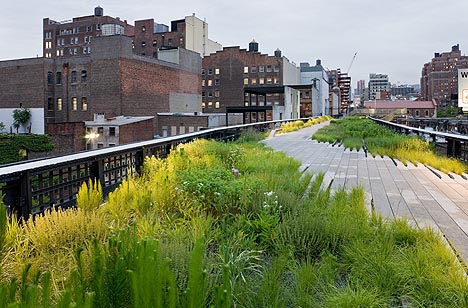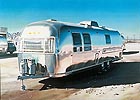
translated and summarized by: Liz Wollner-Grandville,
English summaries December 6 - 19
Künstlerhaus Wien
(re) designing nature. Current concepts of shaping nature in art and landscape architecture
26.11.2010 – 23.01.2011
Landscape revival
The days in which nature led a shadowy existence in the bio-corner are over. “Guerilla Gardening” – finding alternative use for wastelands - is the new spearhead of the new urban Greens movement. But this is only a vague description of the potential of devoted residents, landscape planners, artists and architects. Nature design is experiencing a renaissance in many contexts and dimensions.
Maria Auböck, the doyenne of Austrian landscape architecture, initiated the exhibition “(re)designing nature at the Künstlerhaus Wien. The curators Iris Meder, Susanne Witzgall and Florian Matzner successfully put together 30 international projects into one show, proving that planning with nature is a multifaceted, often interdisciplinary, extensively sustainable and aesthetically appealing process. “We want to show that there are many connecting conceptual elements and main areas of content between art and landscape architecture”.
Reflexive art concepts – cropped like Rorschach-test look-alikes, Regula Dettwiler`s herbalised leaves and the mobile container landscapes by Lois Weinberger – large-format city alterations, renaturation of former industrial- military areas and landfills: its all there. Even futuristic utopias are represented – such as works by the architect Vincent Callebaut.
The Parapoli Collective installed a temporary winter garden on the sidewalk in front of the Künstlerhaus. In the Stifter Room, the Dutch artists group Observatorium piled Styrofoam parking lot areas to a huge heap. The installation “Into the desert” points to motorized traffic as being an essential landscape element. Michael Rieper`s and Christine Schamuszer`s exhibition architecture focuses on vegetable crates.
Hager Landschaftsarchitektur transformed a 1950`s gas station into a garden, with a pine tree, an evergreen bamboo, a cherry tree, reeds and water in its midst and forming an ideal balance between Mediterranean Fellini-flair and Asian tranquility.
Madrid transferred its city freeway into a 43km tunnel system: West 8/Mrio arquitectos created a magnificent pedestrian zone on top. In reminiscence of the historic royal orchard, fig-, almond-, and pomegranate trees were planted in the “Huerta de la Partida”, and the paving stones of the Avenida de Portugal were mounted in the shape of cherry blossoms. In the urban open “Salon de Pinos” there are 8,000 pines. From here the pedestrian bridge “Peunte Cascare leads to the “Parque de Arganzuela”, where people enjoy a swim, even if prohibited.
James Corner Field Operations and Diller Scofido + Renfro reanimated the overgrown tracks of the New York High Line, which was shut down in 1980, with terraces, benches and viewing platforms to a wonderful park that stretches in airy heights across numerous Manhattan streets. The New York Restoration Project fosters parks and community gardens in disadvantaged districts, with one of them being designed by Ken Smith, designer of the MoMA roof garden.
The most remarkable project comes from India and is called “Ashar macha / Platform of Hope”. In Kabir, Dhaka`s largest slum area, landscape architect Khondaker Hasibul Kabir planted resistant plants that even flourish in contaminated earth. Together with his students he constructed a platform over the river. In the slum, which is mainly inhabited by illegal migrants, an oasis of beauty flourishes. Amidst garbage and barracks there are flowers, shade, fruit, vegetables and a library on stilts over the water. The residents love it.
By Isabella Marboe
Künstlerhaus Wien
1010 Vienna, Karlsplatz 5
Tel: +43 1 587 96 63
www.k-haus.at
Opening hours: Daily 10 a.m. – 6 p.m.
Manifesta 8
On the fringe of the stronghold of Europe
Not far from the megatoursim in Mallorca and Alicante the roving arts Biennale Manifesta is currently taking place in the southern Spanish region of Murcia and focuses on the dialogue with North Africa. A highlight in the international competition of biennales.
The Manifesta starts with the promise of "sounding out the borders of Europe", which means the expansion of the discourse on migration and the rigid boundaries of the European Union on the North-South dimension. This is a logical development in the cities of Murcia and Cartagena in southern Spain because the central migration routes across the Mediterranean from North and West Africa converge here and on the nearby island of Mallorca.
As a result the Manifesta 8 is winsome because it pursues a sensitive pluralistic balanced position. The curator teams of "tranzit.org", the "Chamber of Public Secrets" (CPS) and the Egyptian "Alexendria Contemporary Arts Forum" (ACAF) are dealing with political aspects, but even where concrete social aspects are incorporated, the individual exhibition situations appear relaxed.
A video installation with staged interviews on the streets by Thierry Geoffroy (F / DK) elucidates the prejudices and conflicts under the idyllic surfaces of the venues. Equipped with tropical helmet and safari uniform, the "Artist Colonialist" provokes intelligent small talk situations between old established residents and people with a migration background. Geoffroy's actionistic "work in progress" can be seen in the abandoned and run-down San Anton Prison in Cartagena. Apart from the building of the old post office in Murcia, this is one of the most attractive exhibition locations for the local public, because they have the opportunity to explore the insides of the otherwise closed buildings.
Here one can also see a video by the Spanish filmmaker, Maria Ruido, in which she reprocesses the facets of the workers migration of the 70's from southern Spain to Germany using material from her parents' biography. The dream of a new life ends in assembly line work and sending money home. Interesting from a mid-European point of view because the public discourse is currently entirely centered on the hostility towards Islam.
In Murcia's art museum MUBAM, the formal antithesis is formed by a space-filling multi-channel video installation with concurrent large-screen film projections of the Tyrolean, David Rych, who lives in Berlin. Together with a group of youths from a community home, Rych works in dialogue with six long-time prisoners in the prison of Castellón. While the main film, shown in large projection, concentrates on the prisoners as a group reflecting on episodes of different themes such as the perception of life outside the prison, individual interviews are projected on obliquely positioned video screens situated on the floor, whereby, through the configuration of the monitors, the situation of isolation in the group is assimilated. In concentrated close-ups, a sociogram in the form of an interview emerges about the everyday life of the delinquents, their reflections on their mistakes, chances and perspectives and their expectations of their lives after prison having had six to seven job trainings whilst behind bars, which, however, is certainly no job guarantee. One of the best-documented projects of recent times because it offers different perspectives and comes across as dramaturgically perfect.
But this Manifesta is certainly not designed as a social political pressure chamber, and is naturally only re-censorable on the basis of some highlights. The "transit.org" team developed a pluralistic concept in the former artillery buildings of Murcia with close connections to the African continent, with contributions by Dora Hegy, Vit Havranek and Georg Schöllhammer. It looks as if this team deliberately circumnavigated the formulation of an explicit statement in order to open up a discourse on plurality. A film on Black Culture and something like Afro-futurism is presented in an arte povera setting by the young artist, Neil Beloufa, who lives in Paris. In an almost spooky, mystical scenario taken in Mopti in Mali, the protagonist formulates abstract futuristic fantasies with literary utopian character.
The team of the Alexendria Contemporary Arts Forum, in conjunction with Bassam el Baroni, treats the theme of the cultural transfer between the north African states in a relaxed and open manner at the former central post office of Murcia, where, for example, the Argentinian Pablo Bronstein is exhibiting architectural drawings in which the image transfer between Islamic and southern Spanish everyday culture is carved out. As a kind of landmark of Spain, a camel kisses a bull.
As a large-scale enterprise of modern art in 14 exhibition locations, and with over one hundred artists, this Manifesta can be placed at the forefront of European biennales ex equo with the completely differently conceived Istanbul biennale.
By Roland Schöny
Manifesta8 takes place from 09 October 2010 to 09 January 2011 in the southern Spanish region of Murcia.
www.manifesta8.com
MUMOK Museum moderner Kunst
Hyper Real – The passion of the real in painting and photography
22.10. 2010 – 13.02.2011
Comparative Art
Already at the opening in October one could have guessed this would happen. There were greeting messages, an extensive catalogue was devoted to her, yet she did not show up. Now Irene Ludwig, who, together with her husband, Peter, formed the most important German collector couple, died aged 83. The two art historians, with the financial background of a chocolate company, never collected for private purposes but always for the public. Today, the major part of their acquisitions can be seen in Aachen, Cologne, Coblenz, Vienna, Budapest, St. Petersburg and Beijing.
Long before the hyperrealists had their grand appearance at the documenta V in 1972, the generous Ludwigs already owned principal works, some of which were displayed in Vienna at the former Museum of Modern Art in the Palais Liechtenstein. Now the MUMOK, the Aachener Ludwigsforum and the Budapest Ludwig Muzeum joined forces for an exhibition tour of “Hyper Real” ; and it often seems as if one was meeting old friends.
Realists followed the path of the “American way of life” – between the urban jungle with all its facets and brightly polished suburban idylls. One of the most important followers in Europe was Franz Gertsch. Even decades later these works lost none of their charm: the shadows are slightly harder, the bodies more vivid, the mirroring deeper and their splendor more accentuated. Comparable to Pop-Art and photography of the last two decades by representatives of the Becher-School, Jeff Wall or Thomas Demand – and one constantly tends to question what comes closest to reality.
Similar to the style found in Andy Warhol`s Pop Art or Jean Olvier Hucleaux`s photo-realism, portraits of the founders are shown at the exhibition. They depict what the Ludwigs symbolize as collectors: icons.
By Daniela Gregori
MUMOK Museum moderner Kunst
1070 Vienna, MuseumsQuartier
Tel: +43 1 525 00
www.mumok.at
Opening hours: Tue – Sun 10 a.m. – 6 p.m., Thu 10 a.m. – 9 p.m.
Mehr Texte von translated and summarized by: Liz Wollner-Grandville


 Teilen
Teilen




